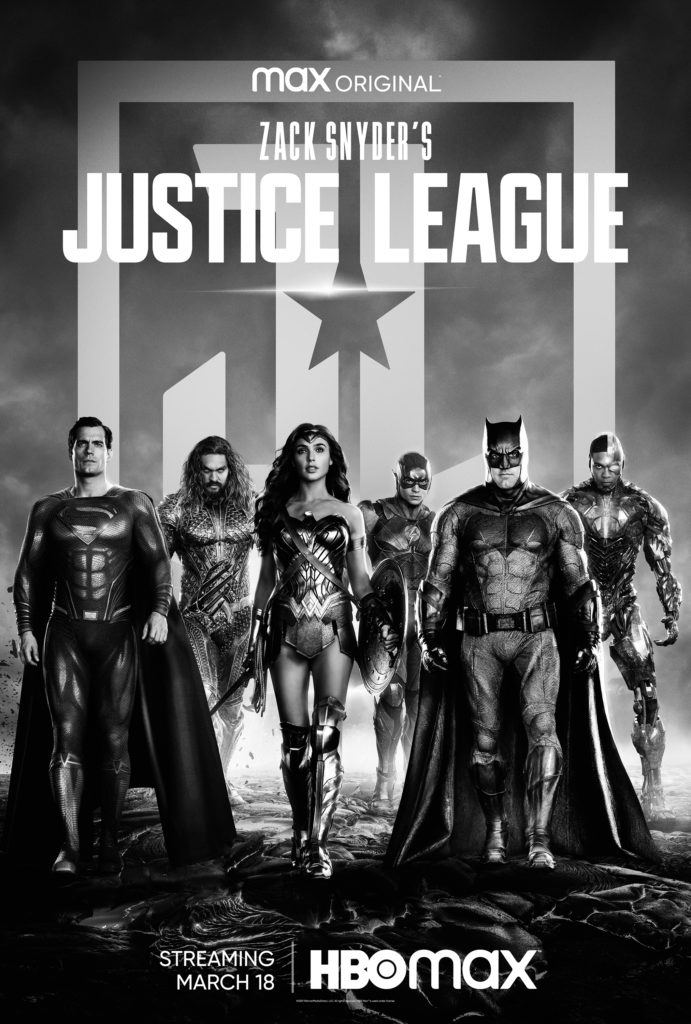A Famously Troubled Production Gets a Do-Over. Has it Been Improved?
DIRECTED BY ZACK SNYDER / 2021

I watched the theatrical cut of Justice League a few days ago to refresh my memory of it so as to make it easier for me to spot changes made to the director’s cut. It’s not a good movie by any means, but it’s hardly a complete trainwreck, especially given its tortuous production process. There are still bits sprinkled throughout that I enjoyed. Mostly, these bits are in the form of the quieter moments where two or more superpeople sit and talk to each other like regular human folk. Some of these bits were the nervous ramblings of the Flash, and some were the big show-stopping superhero moments one should expect in a production of this scale.
Sitting down to watch Zack Snyder’s reclaimed cut of Justice League, I was struck how much of the film remains the same.
It has the advantage of being more… unified in tone and look. The theatrical cut is an unwieldy Frankenstein’s monster, sewn together from movies from two very different directors. Excessive studio meddling mandating a 2-hour runtime, massive reshoots, and a shortened post-production time put more strain on the final film. The need to digitally erase Henry Cavill’s moustache in a rushed job, resulting in an uncanny valley effect on Superman’s face, was just a cherry on top of a misbegotten sundae. Snyder’s cut doesn’t have to deal with any of that. Even though his film was 100 percent complete at the time he had to leave the production, he was given plenty of time, money, and space to finish it up. He wasn’t dealing with the tyranny of a release date that was set down in stone before production even began.

But the result, while unquestioningly Zack Synder’s Justice League, still isn’t that different than the theatrical release. It’s just… longer. The basic story beats remain. Superman (Henry Cavill) remains dead, killed in his attempt to destroy Doomsday in Batman V. Superman. The movie begins with a replay of that climatic scene. Warned by Lex Luthor of an impending invasion at the end of that movie, Batman (Ben Affleck) attempts to gather a group of super-powered individuals to meet this threat. He’s joined by Wonder Woman (Gal Gadot), Aquaman (Jason Momoa), the Flash (Ezra Miller), and Cyborg (Ray Fisher). Together, they oppose Steppenwolf (voiced by Ciarán Hinds) from finding and uniting three “mother boxes” which will spell Earth’s doom. Realizing that their team might not yet be strong enough to succeed, Batman decides that they must attempt bringing Superman back to life (using a lot of alien technology). If Superman does come back, however, whose side will he be on?
The film is divided into six parts, plus a short prologue and an over-long epilogue. It’s the first three parts that track the closest with the theatrical cut, while the points of greater divergence occur during the latter half. Most of the additional material, and frankly the best parts of it, have to do with expanding Cyborg’s story. Both Fisher, and actor Joe Morton who plays his father, have much more to do in this cut. This gives the character, while not a complete cypher in the theatrical version, a greater emotional arc as he comes to terms with his transformation into a half-man, half-machine (well, more like quarter-man, three-quarters machine), and with his father, who was responsible for the transformation, regardless of what it meant for his son’s life.
There isn’t much added that makes the movie better, it just makes it longer.
This storyline would have been a vital element to the theatrical cut, and it’s a shame this is the material left on the cutting room floor at the behest of a studio-mandated running time. After finishing Synder’s 4-hour-long cut, I couldn’t help but think there’s a brilliant 2-and-a-half hour cut that’s the best of both worlds. Because other than the expansion of the Cyborg storyline, there isn’t much added that makes the movie better, it just makes it longer.
Yes, it’s really cool to see a surprise (well, maybe not so much a surprise if you’ve been paying attention to the hype surrounding this release) hero show up, but he doesn’t do anything other than just… show up. Yes, it’s nice to see the Flash rescue Iris West, who’s destined to become the love of his life, but if you didn’t know that was supposed to be Iris West, Justice League has no interest in telling you, and the (lengthy) scene does little other than show off the Flash’s powers to an audience who’s more than likely already acquainted with them. Yes, it’s cool to see Darksied in the (digital) flesh, but he’s still just being set up to be the big bad of a sequel that may never come. So much of this movie is so busy setting up future movies in a franchise whose future is uncertain at best. If it was annoying when Age of Ultron spent so much time table setting, how much worse is it when Justice League does it for movies that won’t be coming out.

But maybe I’m being too pessimistic on this point. Snyder’s Justice League would never have seen the light of day if not for persistent fan pressure on AT&T and Warners these past 4 years. Maybe now that the Snyder cut has been realized, fans will begin a campaign to make Warners produce the Snyder sequels. It’s actually a rather depressing thought. I’ve not been a fan of the direction Snyder thought to take the DC Superheroes in throughout his movies, but I am glad that he got the chance to complete his movie on his terms.
The fact that I didn’t like the end result anymore than I did the theatrical cut is almost besides the point.

